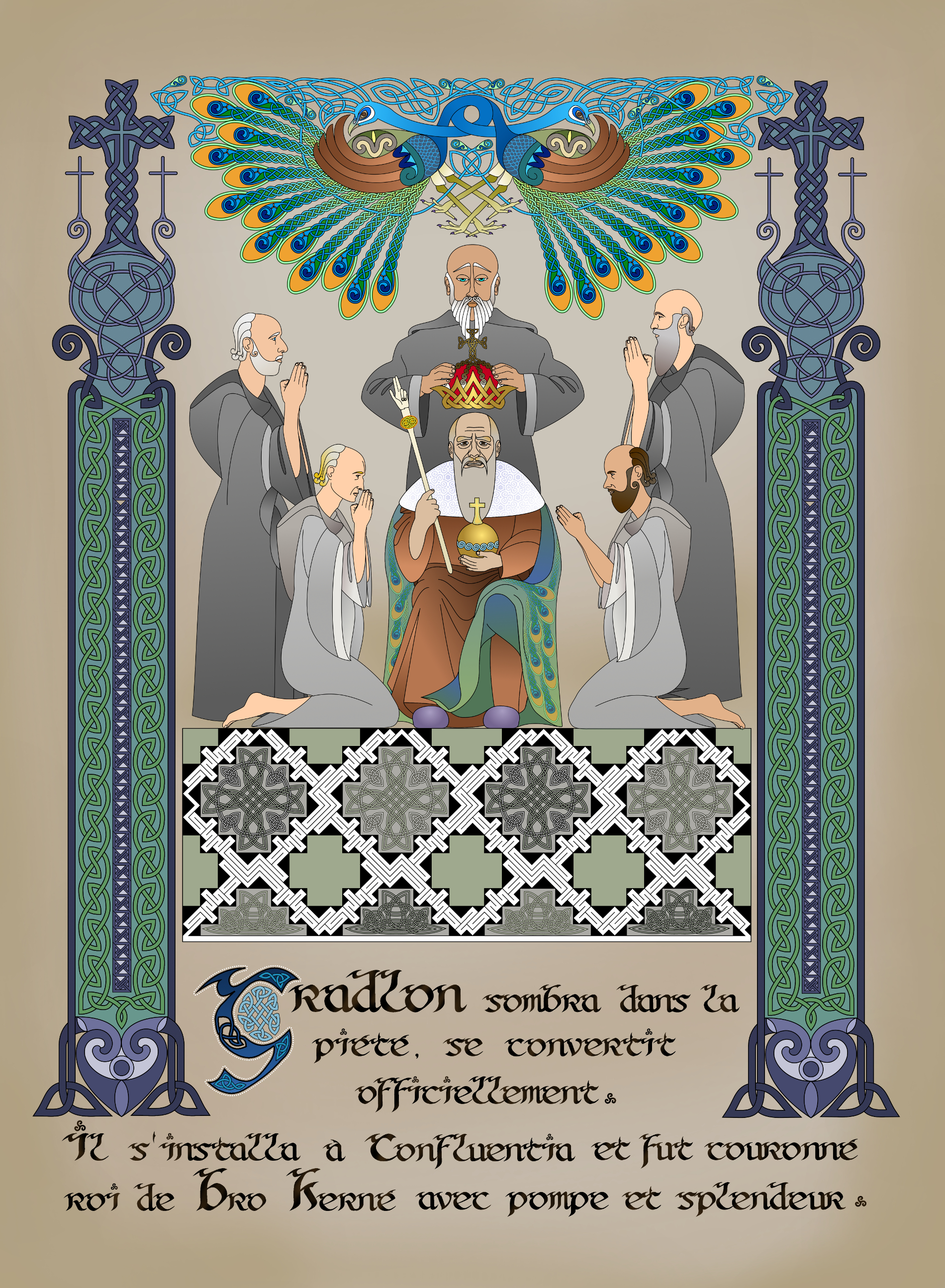fol. 35v
Gradlon sombra dans la piété, se convertit officiellement. Il s'installa à Confluentia(1) et fut couronné roi de Bro Kerné(2) avec pompe et splendeur.
(1) A l'époque où se déroule cette histoire, la cité de Quimper était probablement connu sous le nom de Civitas Aquilonia, mais j'ai choisi Confluentia, bien que ce nom n'apparaisse qu'au XIe siècle. Confluentia est une traduction littérale du breton Kemper.
"Les Romains disparus, une tribu de Bretons émigrés, commandés par Gradlon, s'installe un peu en amont, à la fourche des rivières: Odet, Stéir et Frout, d'où le nom de Kemper, la Ville-Confluent; Confluentia, disent les vieilles chartes." ( P. A B., A travers Quimper, 1930 )
Et selon "la vie de Saint Corentin" (1235) le roi Gradlon aurait fondé Quimper dans le Ve ou VIe siècle. Il aurait donné son château au confluent de l'Odet à l'ermite Corentin pour y construire sa cathédrale.
(2) Bro Kerne: le nom breton de la Cornouaille bretonne. Bien que plusieurs Gradlons historiques aient existé, le "Roi Gradlon" appartient au royaume des légendes.
A propos des insignes royaux: la main de justice ici représentée est un peu anachronique car elle n'a été utilisée en France qu'à partir du XIIe siècle. Mais je pensais que cela donnait une belle symétrie avec la main de bénédiction de Winwallus au fol. 3r.
L'Orbe crucigère semble avoir déjà existé au 5ème siécle, la croix représentant la domination du Christ sur l'orbe du monde, car le monarque est le représentant de Dieu sur Terre.
fol. 35v
Gradlon sank into piety, he officially converted. He settled in Confluentia(1) and was crowned king of Bro Kerné(2) with pomp and splendor.
(1) At the time this story is set, the settlement of Quimper was probably known as Civitas Aquilonia, but I chose Confluentia, although that name does not appear until the eleventh century. Confluentia is a literal translation of the Breton Kemper.
"Once the Romans vanished, a tribe of emigrated Bretons, commanded by Gradlon, settled a little upstream, at the fork of the rivers: Odet, Stéir and Frout, hence the name of Kemper, the City at the Confluence; Confluentia, say the old charters. " ( P. A B., A travers Quimper, 1930 )
And according to "the life of Saint Corentin" (1235) King Gradlon would have founded Quimper in the 5th or 6th century. He would have given his castle at the confluence of the Odet to the hermit Corentin to build his cathedral there.
(2) Bro Kerne: the Breton name for Cornouaille in Brittany. Although several historical Gradlons have existed, "King Gradlon" belongs to the realm of legends.
About the regalia: the hand of justice represented here is a bit anachronistic because it was only used in France from the 12th century on. But I thought it gave a nice symmetry with Winwallus' hand of blessing in fol. 3r.
The cruciferous orb seems to have already existed in the 5th century, the cross representing the domination of Christ over the orb of the world, as the monarch is the representative of God on Earth.
Cliquez l'image pour une meilleure qualité.
Click on the picture for a better quality.

